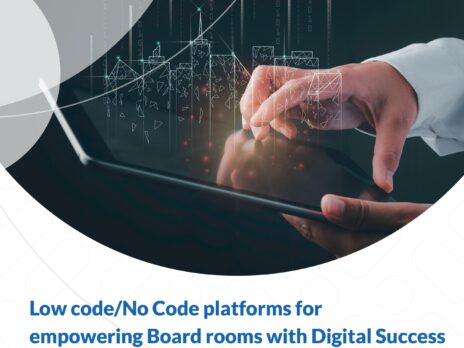
Application development is the backbone of how many organisations drive their business forward, but it does not necessarily mean they have to hire teams of software developers. In the era of low code/no code (LCNC) development, creating high-quality applications at lightning speed is within the grasp of most businesses. But what exactly is LCNC and how can organisations harness its power?
Low code development platforms (LCDPs) are designed for developers and require basic technical knowledge. They enable rapid development by eliminating 90% of the coding process by allowing common, standardised elements to be incorporated using simple drag-and-drop tools.

However, no-code platforms (NCDPs) are aimed at business users and are rapidly growing in popularity, as they enable organisations to create a new application without any coding whatsoever. An organisation can use declarative programming – specifying what they want rather than coding it – and the chosen vendor delivers the application.
“At their core, businesses want to focus on what they are good at,” says Rupesh Mithani, SVP and global Salesforce practice head at digital transformation specialists Hexaware. “They don’t want to focus on IT, but it is the nature of the beast that there are no alternatives. So, LCNC is enabling them.”
“Now, there is a plethora of vendors in the LCNC ecosystem,” he adds. “People want speed and visible results quickly. They want control, and LCNC platforms enable that capability.”
No need to reinvent the wheel
The market for LCNC is growing fast. In a report last year, Gartner forecast the worldwide low code development technologies market would grow by 23% in 2021 alone. As with digital transformation in general, the pace of growth in LCNC has been accelerated by the pandemic.
“In the last two years, problems arose that needed to be solved very quickly, and that catapulted the LCNC category into the spotlight,” says Mithani. “Industry analysts are showing more interest, and companies are developing, for instance, contactless solutions for food service, overnight.”
“The pandemic has certainly accelerated it, with people working from home and companies moving their systems to the cloud,” he adds. “Digital transformation was happening already, and traditional industries were being challenged in many ways by the mobile app economy. The pandemic has pushed these industries to compete with new business models and interact seamlessly with customers.”
As Mithani points out, the appetite for LCNC is rapidly spreading across industries as businesses become more willing to look at how companies in other sectors have solved problems similar to those they face.
“I think this will touch everyone,” he remarks. “In the last couple of months, I have spoken to the CIO of an education texting service, which you would think is a limited industry use case, much narrower than the B2C arena. But why should they develop their own solution if the problem has been solved elsewhere?”
“LCNC makes it possible for industries to borrow business models and IT processes from other industries,” he adds. “Take payment services, which is near a no-code environment now. No one needs to build their own payment platforms because they can leave it to the experts. The customers I interact with don’t restrict their research to their industry segment, they look at examples of how someone might solve a similar problem.”
Failure can be a step towards success
The age of the software-as-a-service (SaaS) LCNC platform is upon us, enabling companies to manage application development without the heavy investments in software engineering. financial services and insurance are among the industries, leading the way in adoption, along with pharmaceutical and life sciences.
“Manufacturing, public services, and government entities are playing catch up, but they are seeing the value in LCNC,” Mithani observes. “Almost every industry now has some LCNC features in its construct, and we could almost argue that the way we consume email in the cloud is an example of no code – nobody has to manage the infrastructure. Single sign-on is another good example of solving a problem that used to be much bigger in the past.”
For those organizations just stepping into the LCNC arena, third-party support can bring the difference between success and failure. But even when organizations fail, the agility and flexibility that LCNC can deliver will enable them to turn that experience into a positive step forward quickly.
“It enables a ‘fail fast learn fast’ model,” Mithani explains. “Some educated customers are making their own choices, and from an investment perspective, they can start small and build out, learning quickly from their mistakes. With LCNC, results come very quickly. It is like buying a car – if you don’t like it, you can sell it; you are not stuck with it.”
Traditional systems are converging towards the LCNC construct, and Hexaware has taken this concept to market in many industries. One client automated its entire leasing process as part of a low-income housing solution for a city in North America. The project, which involved extensive automation and digitization for citizens and state employees to optimize low-income housing, was completed in just six months.
For a leading recycling company in the UK, Hexaware reworked the existing manual processes in a long and complex onboarding process using solutions based on Dynamics 365, an LCDO platform, to streamline customer onboarding and create dedicated channels for customer service. The client saw service efficiency improve by 40%, and renewal rates increase by 20%.
“One of the differences that Hexaware brings is its outside-the-box design thinking in collaboration with business,” says Mithani. “Also, we keep user experience and adoption at the centre of the development process. We have a design studio focused on LCNC where customers can experiment without investing.”
“Many customers tend to be too focused on solving problems, but we get them to bring friction areas into the development to improve adoption and user experience from the early stages. After all, we have to ensure an application gets accepted. Adoption is the starting point for us, not an afterthought.”








